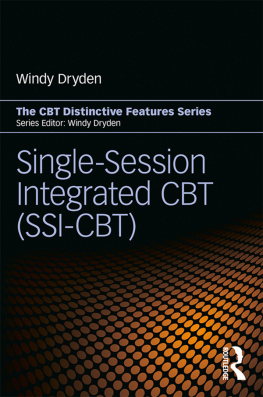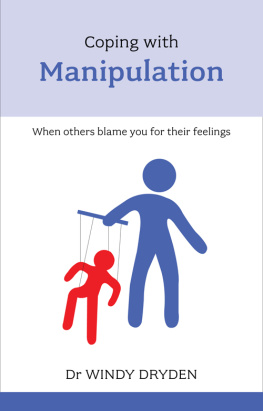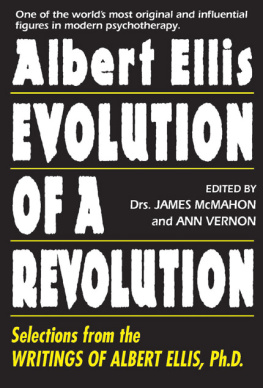Dryden - Single session integrated CBT: distinctive features
Here you can read online Dryden - Single session integrated CBT: distinctive features full text of the book (entire story) in english for free. Download pdf and epub, get meaning, cover and reviews about this ebook. City: London;New York, year: 2017, publisher: Routledge, genre: Romance novel. Description of the work, (preface) as well as reviews are available. Best literature library LitArk.com created for fans of good reading and offers a wide selection of genres:
Romance novel
Science fiction
Adventure
Detective
Science
History
Home and family
Prose
Art
Politics
Computer
Non-fiction
Religion
Business
Children
Humor
Choose a favorite category and find really read worthwhile books. Enjoy immersion in the world of imagination, feel the emotions of the characters or learn something new for yourself, make an fascinating discovery.
- Book:Single session integrated CBT: distinctive features
- Author:
- Publisher:Routledge
- Genre:
- Year:2017
- City:London;New York
- Rating:5 / 5
- Favourites:Add to favourites
- Your mark:
- 100
- 1
- 2
- 3
- 4
- 5
Single session integrated CBT: distinctive features: summary, description and annotation
We offer to read an annotation, description, summary or preface (depends on what the author of the book "Single session integrated CBT: distinctive features" wrote himself). If you haven't found the necessary information about the book — write in the comments, we will try to find it.
Dryden: author's other books
Who wrote Single session integrated CBT: distinctive features? Find out the surname, the name of the author of the book and a list of all author's works by series.
Single session integrated CBT: distinctive features — read online for free the complete book (whole text) full work
Below is the text of the book, divided by pages. System saving the place of the last page read, allows you to conveniently read the book "Single session integrated CBT: distinctive features" online for free, without having to search again every time where you left off. Put a bookmark, and you can go to the page where you finished reading at any time.
Font size:
Interval:
Bookmark:
First published 2017
by Routledge
2 Park Square, Milton Park, Abingdon, Oxon OX14 4RN
and by Routledge
711 Third Avenue, New York, NY 10017
Routledge is an imprint of the Taylor & Francis Group, an informa business
2017 Windy Dryden
The right of Windy Dryden to be identified as author of this work has been asserted by him in accordance with sections 77 and 78 of the Copyright, Designs and Patents Act 1988.
All rights reserved. No part of this book may be reprinted or reproduced or utilised in any form or by any electronic, mechanical, or other means, now known or hereafter invented, including photocopying and recording, or in any information storage or retrieval system, without permission in writing from the publishers.
Trademark notice: Product or corporate names may be trademarks or registered trademarks, and are used only for identification and explanation without intent to infringe.
British Library Cataloguing in Publication Data
A catalogue record for this book is available from the British Library
Library of Congress Cataloging in Publication Data
Names: Dryden, Windy, author.
Title: Single session integrated CBT : distinctive features / Windy
Dryden.
Other titles: CBT distinctive features series.
Description: London ; New York : Routledge, 2017. | Series: CBT
distinctive features series | Includes bibliographical references.
Identifiers: LCCN 2016017946 | ISBN 9781138639522 (hardback) |
ISBN 9781138639591 (pbk.) | ISBN 9781315623122 (ebook)
Subjects: | MESH: Cognitive Therapymethods | ProfessionalPatient
Relations
Classification: LCC RC489.C63 | NLM WM 425.5.C6 | DDC 616.89/
1425dc23
LC record available at https://lccn.loc.gov/2016017946
ISBN: 978-1-138-63952-2 (hbk)
ISBN: 978-1-138-63959-1 (pbk)
ISBN: 978-1-315-62312-2 (ebk)
Typeset in Times New Roman
by Apex CoVantage, LLC

The face-to-face session: 7: Making an impact
You may recall that in the pre-session phone contact, I outlined a number of areas where you need to gather information to assist you in helping your client to get the most out of the SSI-CBT process. The purpose of getting this information is to make SSI-CBT an impactful experience for your client. While I have chosen to put this material here in that it is often when the client can understand the importance of developing new meaning in relation to the adversity at A that you can concentrate on increasing the impact of such understanding this issue is relevant throughout the process. Here is a list of strategies that may help make the SSI-CBT process more impactful for your clients. Please bear in mind that one well-chosen strategy is likely to be more helpful than trying overly hard to increase the impact of therapy using several strategies in a short period of time. In SSI-CBT here as elsewhere, often less is more.
It is difficult to know what is going to resonate with your client with respect to helping them deal with their target problem. Here are a few tips, though. First, you need to listen carefully to the language that your client uses in their contacts with you. If they use certain words or phrases frequently then this may be one indication that such language is meaningful to them, particularly if it is accompanied by affect. The same applies to any recurrent imagery to which they may refer. Second, watch carefully to see if your client demonstrates engagement with the language and concepts that you use in the sessions. Such engagement may be marked by affect, an increase in attention, forward leaning and the repetition of language that you may use. How you use any of this material will vary from client to client, but the best way of doing so will be to promote cognitive change which will be facilitated if the client is emotionally engaged in this process.
During the pre-session phone conversation, I suggested that you find out what experiences your client has had in being helped and helping themselves both in general and, more specifically, with respect to their target problem. Then, you can use these helping principles and self-helping principles to facilitate change with respect to this problem.
Eugene indicated that exposure to threat and tolerating discomfort while he did so helped him with a problem earlier in his life. Consequently, I used a number of opportunities to remind him of his successful application of these principles and helped him to see how he could use them while tackling his target problem. In addition, I showed Eugene how he could rehearse his flexible and self-accepting beliefs prior to giving a group presentation and to hold these beliefs in mind while he was in the situation.
When you know what strengths your client considers they have you can make reference at judicial times in the SSI-CBT process to these strengths in order to make their self-change efforts more meaningful and therefore more impactful.
When Eugene expressed a doubt about his capability to apply some of the ideas that we discussed in the face-to-face session, I reminded him that with determination (his stated strength) he may surprise himself concerning what he could achieve. He seemed to resonate with this way of linking determination as a response to such doubt.
Making reference to your clients selected role model or someone who has been helpful to your client can galvanize your client, particularly when they appear to be flagging. What is more important is helping your client keep the person in mind after the face-to-face session when putting into practice what they have learned in the session.
Eugenes selected his paternal grandfather as someone who might be influential in the SSI-CBT and pointed to a helpful saying that he associated with his grandfather, namely, What is very bad now, will not seem so bad in the morning. This phrase nicely encapsulates the non-extreme belief known as a nonawfulizing belief and I encouraged Eugene to use a version of it, should he encounter people who did regard his nervousness as a defect: It might seem awful at the time if people thought that my nervousness was a defect, but it would not seem so bad the next day. Eugene said that if he imagined his grandfather saying this to him with his arm placed around Eugenes shoulder that this would be particularly impactful and I encouraged him to do so.
The more you can utilize your clients learning, the more likely it is that they will derive benefit from the SSI-CBT, assuming that they relate to the ideas that you have helped them develop.
Eugene said that he learns best by giving himself some time to think things through and particularly disliked being rushed. Although it may seem that this would pose a particular challenge given that time is at a premium in SSI-CBT. However, I encouraged Eugene to take his time at various points in the process and the time he devoted to doing so was, in my opinion, well spent since he appeared to be more involved in the process at the end of each period of reflection. He also came up with a few reservations about the usefulness of flexible beliefs that revealed some misconceptions about this concept that I was able to address and once Eugene took his time to digest my points he became more committed to the constructiveness of flexibility of belief.
Font size:
Interval:
Bookmark:
Similar books «Single session integrated CBT: distinctive features»
Look at similar books to Single session integrated CBT: distinctive features. We have selected literature similar in name and meaning in the hope of providing readers with more options to find new, interesting, not yet read works.
Discussion, reviews of the book Single session integrated CBT: distinctive features and just readers' own opinions. Leave your comments, write what you think about the work, its meaning or the main characters. Specify what exactly you liked and what you didn't like, and why you think so.













